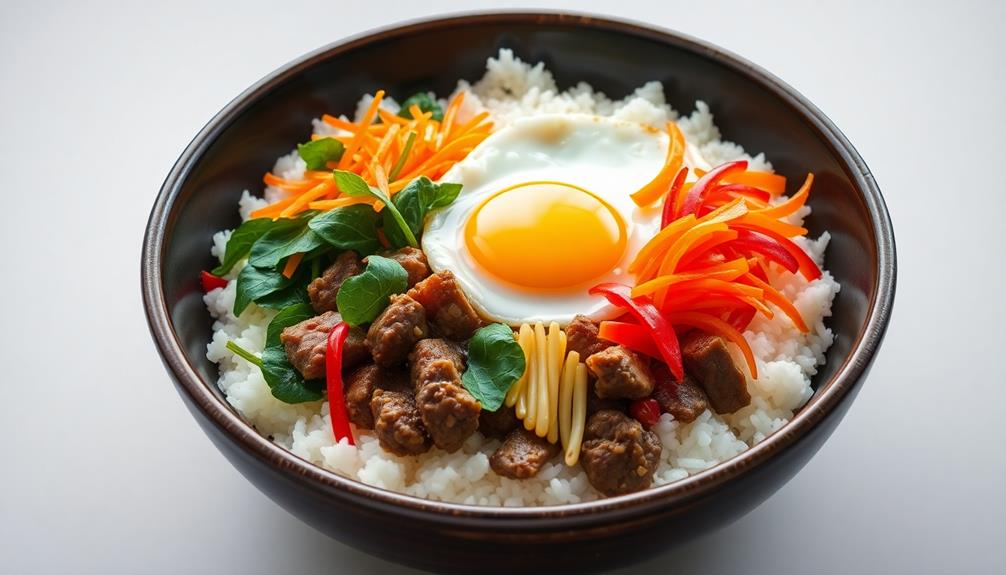Korean temple cuisine focuses on mindful cooking with minimal seasoning, emphasizing natural flavors and balance. You’ll choose ingredients reverently, preparing them slowly and attentively like meditation. Seasonings are kept simple, often just salt or fermented pastes, allowing the true essence of vegetables and grains to shine. This approach nurtures both body and spirit, transforming eating into a respectful ritual. If you keep exploring, you’ll discover how this mindful practice fosters harmony and appreciation in every bite.
Key Takeaways
- Emphasizes slow, deliberate cooking that treats ingredients with reverence, fostering mindfulness and spiritual connection.
- Uses minimal seasoning, such as salt or fermented pastes, to highlight natural flavors of vegetables and grains.
- Focuses on plant-based ingredients prepared with care, promoting balance, harmony, and respect for nature.
- Encourages mindful eating practices that cultivate gratitude, moderation, and sensory awareness during meals.
- Integrates philosophical principles of simplicity and spiritual discipline to create nourishing, meaningful culinary experiences.

Korean temple cuisine offers a unique glimpse into a culinary tradition rooted in simplicity, mindfulness, and spiritual discipline. When you explore this style of cooking, you start to see how food becomes more than just nourishment—it’s a practice of meditation practices that cultivates inner peace and awareness. The focus is on creating balance and harmony through minimal seasoning, allowing the natural flavors of ingredients to shine. This approach aligns closely with the principles of plant-based nutrition, emphasizing vegetables, grains, and legumes over meat or heavy sauces. By preparing your meals this way, you’re not just eating healthily; you’re engaging in a form of mindful practice that supports your spiritual and physical well-being.
In Korean temple cuisine, each ingredient is chosen with care, often prepared with a sense of reverence and respect for nature. The cooking process itself becomes a form of meditation—slow, deliberate, and attentive. You pay close attention to the textures, colors, and aromas of your ingredients, fostering a deeper connection with what you’re about to eat. This mindfulness in preparation encourages you to be present, reducing distractions and helping you appreciate the simplicity of each bite. The minimal use of seasoning, typically limited to salt, soy sauce, or fermented pastes, allows the true essence of the vegetables and grains to come forward. This restraint not only highlights the natural flavors but also encourages a more conscious consumption, where each taste is savored and appreciated. Additionally, the practice of mindful eating in this tradition can enhance your overall awareness of sensory experiences, which is a core aspect of cultivating Cultural Intelligence.
You’ll find that plant-based nutrition in Korean temple cuisine isn’t just about health; it’s a spiritual practice that emphasizes moderation and gratitude. Eating this way helps cultivate a sense of humility and respect for the food and the effort that went into its growth and preparation. It encourages you to slow down your eating process, paying attention to how your body responds to each bite, fostering a deeper awareness of hunger, fullness, and satisfaction. This mindful approach can transform your relationship with food from a hurried act into a meaningful ritual that nourishes both body and mind. Moreover, understanding how AI safety measures are integrated into technology can inspire more mindful choices in adopting new innovations responsibly. Recognizing the importance of scientific integrity ensures that innovations serve society ethically and effectively.
Frequently Asked Questions
How Can I Adapt Temple Cuisine for Modern Dietary Preferences?
To adapt temple cuisine for modern dietary preferences, you can incorporate vegan substitutes like tofu or tempeh to replace meat and eggs. Use gluten-free grains such as rice or millet to make dishes accessible for gluten sensitivities. Focus on fresh vegetables, miso, and seaweed for flavor, avoiding heavy seasoning. This mindful approach preserves the essence of traditional temple cooking while accommodating diverse dietary needs, making it both nourishing and inclusive.
Are There Specific Ingredients Unique to Korean Temple Cooking?
You’ll find that Korean temple cooking uses unique vegetarian ingredients like wild greens, fermented soybean products, and various mushrooms. Traditional herbs such as ginseng, sesame, and garlic add depth without overpowering the dish. These ingredients highlight natural flavors and promote mindfulness. Incorporating them allows you to embrace authentic flavors while keeping your meals simple, nourishing, and aligned with the mindful principles of temple cuisine.
What Are Common Utensils Used in Preparing Temple Dishes?
Imagine your kitchen as a sacred garden, where each utensil is a gentle tool tending to delicate flavors. In traditional cooking, you’ll find utensil varieties like wooden spoons, stone grinders, and clay pots, essential for crafting temple dishes. These tools help you preserve the purity of ingredients, allowing the natural essence to shine through. With mindful use, your utensils become extensions of your intention, creating harmony in every meal you prepare.
How Does Temple Cuisine Influence Korean Cultural Practices?
You see, temple cuisine influences Korean cultural practices by emphasizing meditative eating and spiritual discipline. When you practice mindful eating, you’re encouraged to savor each bite, fostering gratitude and inner peace. This approach reflects a broader cultural value of harmony and respect for nature. By incorporating these principles into daily life, you help preserve spiritual traditions and promote a peaceful, mindful way of living rooted in Korean heritage.
Can Temple Recipes Be Easily Replicated at Home?
You might think replicating temple recipes at home is tough, but it’s quite doable with a few tips. Without relying on heavy seasonings, you can use vegetarian substitutions like mushrooms or tofu to mimic textures. Focus on flavor enhancement through natural ingredients like kelp or dried seaweed. With patience and mindful preparation, you’ll create authentic, nourishing dishes that honor the simplicity and depth of temple cuisine.
Conclusion
Embrace Korean temple cuisine like a gentle river flowing through a quiet forest—calm, pure, and intentionally simple. Let each mindful bite wash over you, revealing the beauty in minimalism and subtle flavors. As you cook and eat with reverence, you’ll discover that true nourishment isn’t just about filling your stomach but nourishing your spirit. In this mindful approach, every meal becomes a peaceful meditation, a harmonious dance between nature, soul, and sustenance.










